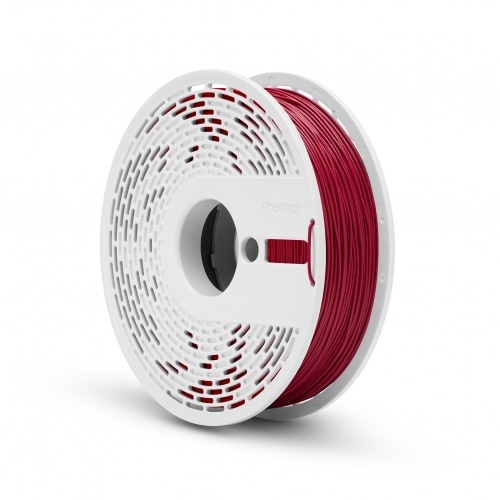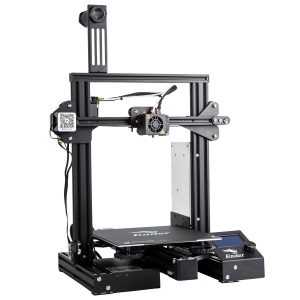
Fiberlogy FiberFlex 30D Burgundy 1.75 mm 850 g
F30-BURGUNDY-175-085
Brand: Fiberlogy, Poland
Fiberlogy FiberFlex 30D is a high-quality flexible filament with Shore 30D hardness, providing exceptional elasticity and rubber-like properties for creating flexible functional products.
- Strength: Medium | Flexibility: Very High
- Printing Difficulty: High (recommended for experienced users)
- Printing Temperature: 200°C - 220°C
- Bed Temperature: 50°C - 70°C
- High impact resistance at low temperatures
- Excellent thermal and chemical resistance
- Elongation at break: 870%
- NET weight: 850 g
Description of Fiberlogy FiberFlex 30D Filament for 3D Printers
3D For You offers you the opportunity to purchase Fiberlogy FiberFlex 30D filament with 1.75 mm diameter and 850 g weight to experience the unique capabilities of 3D printing with flexible materials.
FiberFlex 30D is a high-quality elastic filament with reduced hardness that provides exceptional flexibility for finished products. This is the second filament from the FiberFlex family, whose high elasticity allows you to create 3D printed objects for projects that require rubber-like properties.
With a Shore 30D hardness, this filament offers excellent elasticity and flexibility while maintaining good strength and durability. Any project requiring resistance to bending, compression, or stretching may benefit from this material.
3D printing with Shore 30D hardness flexible filament requires some experience in this field and an appropriate 3D printer. Therefore, this ultra-soft material, like TPU filaments with similar Shore hardness, may be challenging for beginners. It is strongly recommended to use a direct drive extruder and reduce printing speed. Decreasing the pressure on the extruder gear may also help achieve successful printing.
From other flexible filament options with hardness greater than 30D, you might also be interested in Fiberlogy FiberFlex 40D and Fiberlogy MattFlex 40D.

3D4U is the official distributor of the Polish brand Fiberlogy in Ukraine.
Our offer includes a wide range of filament for 3D printing. We provide professional consultation and guarantee that all Fiberlogy products presented are original.
Properties of Fiberlogy FiberFlex 30D Filament
Fiberlogy FiberFlex 30D filament stands out among other flexible materials for 3D printing thanks to its unique characteristics that make it indispensable for creating elastic and flexible products.
- Shore 30D hardness - provides an excellent balance between flexibility and strength
- High impact resistance at low temperatures - products maintain elasticity even in cold conditions
- Excellent thermal, chemical, and abrasion resistance - increases the durability of finished products
- Superior elasticity - allows creating parts that can be repeatedly bent without damage
- Dimensional stability - ensures printing accuracy and predictable mechanical properties
Important: Unlike standard materials for 3D printing such as PLA or PETG, flexible filaments require special printer settings and some experience. Using a direct drive extruder is recommended for the best results.
Applications of FiberFlex 30D
Thanks to its high flexibility and elasticity, Fiberlogy FiberFlex 30D is ideal for a wide range of applications where rubber-like properties are required:
- Rubber elements for mechanisms: gaskets, seals, parts that are frequently bent
- Gadgets and their components: phone cases, watchbands, heart rate monitors, pedometer straps
- Connecting elements: flexible hinges, dampers, adapters
- Toys and their components: tires, rubber figures, flexible components
- Jewelry: bracelets, elastic elements for accessories
- Functional prototypes: parts requiring flexibility and elasticity during testing
- Protective cases and covers: shock-absorbing elements for electronics and fragile devices
The ultra-soft FiberFlex 30D filament is especially valuable when creating products that need to mimic rubber or silicone while maintaining the strength and durability of a thermoplastic material.
Printing Parameters for Fiberlogy FiberFlex 30D
The following parameters are recommended print settings for this material. To ensure the best print quality, it is necessary to select appropriate settings for your specific printer and printing conditions.
| Parameter | Value |
|---|---|
| Nozzle Temperature | 200-220°C |
| Bed Temperature | 50-70°C |
| Closed Chamber | not required |
| Cooling Fan | 50-75% |
| Flow Rate | 105-110% |
| Print Speed | < 35 mm/s |
| Print Surface | glass, masking tape, 3DLAC |
| Retraction (direct extruder) | 1-2 mm |
| Retraction Speed | 10-30 mm/s |
| Drying Conditions | 60°C / 4h |
Note: Products made from flexible materials, including FiberFlex 30D, have high adhesion to the print surface. To facilitate model removal, you can heat the bed to 60-90°C after printing is complete — this often helps separate the model without damage. When printing on glass, in some cases it's more effective to wait for the surface to cool completely. Remove the model carefully to avoid deforming the flexible part.
Technical Specifications of FiberFlex 30D
| Parameter | Value | Test Method |
|---|---|---|
| Diameter | 1.75 mm ± 0.05 mm | - |
| Density | 1.07 g/cm³ | ISO 1183 |
| Shore A Hardness | 81 | ISO 7619 |
| Shore D Hardness | 30 | ISO 7619 |
| Tensile Strength | 22 MPa | ISO 527 |
| Elongation at Break | 870% | ISO 527 |
| Melting Temperature | 170°C | DSC |
| Heat Distortion Temperature | 70°C | ISO 75 |
Tips for 3D Printing with FiberFlex 30D
Printing with flexible filaments can present certain challenges, especially for beginners. Here are some tips to help you achieve the best results when working with Fiberlogy FiberFlex 30D:
- Use a direct drive extruder - it provides better control over the flexible filament feed and reduces the risk of twisting or jamming.
- Print slowly - the print speed for FiberFlex 30D should be significantly lower than for rigid materials (no more than 35 mm/s is recommended).
- Minimize retraction - flexible materials respond poorly to long retractions, so it's recommended to reduce the retraction distance to 1-2 mm when using a direct extruder.
- Disable retraction when using a Bowden extruder - if your printer is equipped with a Bowden extruder, it's better to completely disable retraction and set up a print mode without stringing using other methods.
- Increase the flow rate - flexible materials often require a slight increase in flow rate (up to 105-110%) to fill all voids.
- Ensure good bed adhesion - use adhesives such as 3DLAC for secure attachment of the first layer.
- Dry the filament before printing - flexible TPU-like materials are hygroscopic and can absorb moisture from the air, which negatively affects print quality. Drying at 60°C for 4 hours before use is recommended.
Tip: If you experience problems with filament feeding, try reducing the pressure on the extruder gear. Too much compression can deform the flexible material and cause it to jam.
Comparison with Other Flexible Materials
The Fiberlogy flexible filament line presents various materials with different degrees of hardness and unique properties. The choice of a specific material depends on your project requirements.
| Material | Shore Hardness | Key Differences | When to Choose |
|---|---|---|---|
| FiberFlex 30D | 30D | Maximum flexibility, ultra-high elasticity | For the most flexible and elastic products that mimic rubber |
| FiberFlex 40D | 40D | Higher hardness, good balance of flexibility and strength | For projects requiring a balance between flexibility and strength |
| MattFlex 40D | 40D | Matte surface, improved aesthetics | For aesthetic flexible products with a matte finish |
| FiberFlex CF | 60D | Contains carbon fiber, increased strength | For high-strength flexible components requiring mechanical resistance |
| TPU | 55D | Standard thermoplastic polyurethane from other manufacturers | Alternative when medium flexibility is needed |
Fiberlogy FiberFlex 30D stands out among other flexible materials for its exceptional elasticity and softness, making it an ideal choice for projects requiring maximum flexibility and properties closest to rubber.
Why Choose Fiberlogy FiberFlex 30D
Fiberlogy FiberFlex 30D represents an optimal solution for creating flexible and elastic products thanks to several key advantages:
- Exceptional flexibility - Shore 30D hardness provides high elasticity comparable to soft rubber
- Multiple deformations without breaking - the material withstands numerous cycles of bending, stretching, and compression without losing its properties
- Chemical resistance - resistance to a wide range of chemicals makes it suitable for use in aggressive environments
- Abrasion resistance - ensures long service life for parts subject to friction and mechanical impact
- Consistent quality - Fiberlogy products undergo strict quality control, guaranteeing consistency of properties from batch to batch
- Wide range of operating temperatures - maintains flexibility even at low temperatures
- Professional results - allows creating functional flexible parts of industrial quality
By choosing Fiberlogy FiberFlex 30D from the official distributor 3D4U, you receive not only a high-quality material for 3D printing but also a guarantee of product authenticity, professional support, and fast delivery throughout Ukraine.
How to Order Fiberlogy FiberFlex 30D
Ordering Fiberlogy FiberFlex 30D in Ukraine is very simple through the 3D4U online store:
- Select the desired filament color from our catalog
- Add the product to your cart
- Proceed to checkout
- Confirm your order
If you have any questions about Fiberlogy products or the ordering process, our specialists are always ready to provide consultation by phone or email. We value every customer and strive to ensure the most comfortable process for purchasing and using 3D materials.
Start creating unique flexible products today with Fiberlogy FiberFlex 30D filament!
FAQ (Frequently Asked Questions) about Fiberlogy FiberFlex 30D
The 30D marking indicates the material's hardness on the Shore D scale, which is used to measure the hardness of plastics and rubber. The lower the number, the softer and more elastic the material. The Shore D scale is used for harder materials, while the Shore A scale is for softer ones. FiberFlex 30D has a hardness of 30 on the Shore D scale (which is equivalent to approximately 81 on the Shore A scale), making it very flexible and elastic, with properties similar to soft rubber.
Printing FiberFlex 30D on a printer with a Bowden extruder is possible but significantly complicated due to the high flexibility of the material. The long Bowden tube can cause the filament to twist and jam. If you are using a printer with a Bowden extruder, it is recommended to:
- Minimize or completely disable retraction
- Significantly reduce print speed (to 10-15 mm/s)
- Ensure the filament travels along the most direct path possible
- Use a high-quality PTFE tube with a minimal internal diameter
However, you will achieve the best results using a 3D printer with a direct drive extruder.
Unlike ABS or PLA, FiberFlex 30D is resistant to most common solvents used for smoothing 3D printed objects. Traditional smoothing methods using acetone or other solvents are not effective for this material. To improve the appearance and tactile feel of products printed from FiberFlex 30D, it is recommended to:
- Print with thinner layers (0.1-0.15 mm) to improve surface quality
- Use mechanical post-processing (sanding with very fine sandpaper)
- Apply heat treatment (careful heating with hot air to smooth the surface)
- Use special coatings compatible with TPU/TPE materials
The chemical resistance of FiberFlex 30D, while limiting smoothing possibilities, is an advantage for parts that will be exposed to various environments.
Products printed from FiberFlex 30D exhibit high durability thanks to the unique combination of flexibility and strength of the material. They can withstand:
- Multiple deformation cycles without losing shape and properties
- Exposure to a wide temperature range (from -30°C to +70°C)
- Contact with most household chemicals
- Abrasion and mechanical loads
- UV radiation (with minimal color change)
When properly printed and used as intended, products made from FiberFlex 30D can last for years. However, their durability may decrease with prolonged exposure to direct sunlight, strong oxidizers, or temperatures above 70°C.
Print speed can influence the final properties of FiberFlex 30D products, but to a lesser extent the flexibility itself, which is determined by its chemical composition. However, print speed directly affects:
- Layer adhesion: At low print speeds, the adhesion between layers improves, which can increase elasticity and strength in the Z direction.
- Filling of thin walls: Slower printing provides better filling of small details, which affects the overall structural integrity of the product.
- Dimensional accuracy: Optimal print speed ensures more accurate correspondence between actual and specified dimensions, which is especially important for functional parts.
To achieve optimal flexibility and strength, it is recommended to print FiberFlex 30D at a speed not exceeding 35 mm/s, and for particularly complex parts or those with thin elements, to reduce the speed to 15-20 mm/s.
Flexible filaments such as FiberFlex 30D are more hygroscopic than standard plastics for 3D printing and require special storage conditions to maintain optimal properties:
- Store the filament in its original vacuum packaging until use
- After opening the package, store the spool in an airtight container with silica gel
- Avoid exposure to direct sunlight and high temperatures
- Maintain low humidity in the storage area (ideally below 20%)
- After printing, it is recommended to remove the filament from the printer and store it properly
- Before long-term storage, dry the filament at 60°C for 4 hours
Proper storage of FiberFlex 30D prevents moisture absorption, which can lead to deterioration in print quality, bubbles, stringing, and reduced mechanical properties of finished products.
You can determine if a flexible FiberFlex 30D filament has absorbed excessive moisture by the following signs:
- Sound effects: Hissing, crackling, or popping during extrusion
- Visual effects during printing: Appearance of bubbles or steam from the nozzle
- Extrusion problems: Uneven feeding, under-extrusion, or nozzle clogging
- Surface defects: Rough surface, excessive stringing between parts
- Physical condition of the filament: Matte appearance (instead of natural gloss), brittleness when bent
- Mechanical properties of finished products: Reduced elasticity, tendency to break along layers
If you notice any of these signs, it is recommended to dry the filament before continuing printing. Drying at 60°C for 4-6 hours in a special filament dryer or household dehydrator usually helps restore the optimal properties of the material.
| Manufacturer | Fiberlogy |
|---|---|
| Printing technology | FDM/FFF |
| Material type | FLEX |
| Printing temperature, ℃ | 200-220 |
| Platform temperature, ℃ | 50-70 |
| Filament diameter, mm | 1.75 |
| Allowable deviation, mm | ±0.02 |
| Density, kg/m³ | 1070 |
| Color | Burgundy Red |
| Surface Finish / Effect | Standard |
| Filler / Additives | No Additives |
| Heat Resistance | Basic (Up to 70°C) |
| Specific Resistance | Chemically Resistant Wear Resistant / Low Friction |
| Flexibility (Shore Hardness) | Very Soft (~30D / 81A) |
| Spool Format | Standard Spool |
| Length, m | 330 |
| Weight, kg | 0.850 |
| Country | Poland |
| Condition | New |
No reviews for the product










